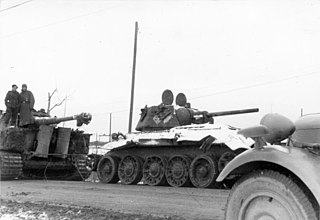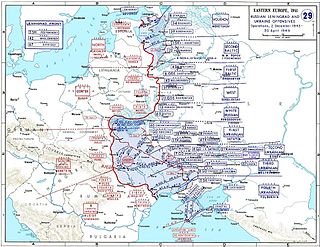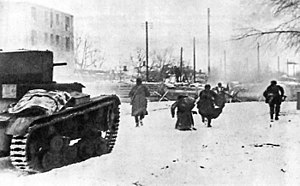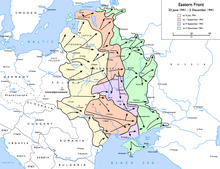
Karl Rudolf Gerd von Rundstedt was a German Generalfeldmarschall in the Heer (Army) of Nazi Germany during World War II. Born into a Prussian family with a long military tradition, von Rundstedt entered the Prussian Army in 1892. During World War I, he served mainly as a staff officer. In the interwar period, he continued his military career, reaching the rank of Colonel General before retiring in 1938.

Fritz Erich Georg Eduard von Manstein was a German Generalfeldmarschall in the Heer (Army) of Nazi Germany during World War II. He was subsequently convicted of war crimes and sentenced to 18 years imprisonment.

The Third Battle of Kharkov was a series of battles on the Eastern Front of World War II, undertaken by Army Group South of Nazi Germany against the Soviet Red Army, around the city of Kharkov between 19 February and 15 March 1943. Known to the German side as the Donets Campaign, and in the Soviet Union as the Donbas and Kharkov operations, the German counterstrike led to the recapture of the cities of Kharkov and Belgorod.

Paul Ludwig Ewald von Kleist was a German Generalfeldmarschall of the Wehrmacht during World War II. Born into the Prussian noble family von Kleist, Kleist entered the Prussian Army in 1900 and commanded a cavalry squadron during World War I. Kleist joined the Reichswehr of inter-war Germany before being discharged in 1938.

Operation Winter Storm, a German offensive in December 1942 during World War II, involved the German 4th Panzer Army failing to break the Soviet encirclement of the German 6th Army during the Battle of Stalingrad.
Army Group A was the name of three distinct army groups of the Heer, the ground forces of the Wehrmacht, during World War II.

The 1st SS Panzer Division Leibstandarte SS Adolf Hitler or SS Division Leibstandarte, abbreviated as LSSAH, began as Adolf Hitler's personal bodyguard unit, responsible for guarding the Führer's person, offices, and residences. Initially the size of a regiment, the LSSAH eventually grew into an elite division-sized unit during World War II.

Case Blue was the Wehrmacht's plan for the 1942 strategic summer offensive in southern Russia between 28 June and 24 November 1942, during World War II. The objective was to capture the oil fields of Baku, Grozny and Maikop for two purposes: to enable the Germans to re-supply their low fuel stock and also to deny their use to the Soviet Union, thereby bringing about the complete collapse of the Soviet war effort.

Operation Little Saturn was a Red Army offensive on the Eastern Front of World War II that led to battles in Don and Chir rivers region in German-occupied Soviet Union territory in 16–30 December 1942.
The 1st Panzer Army was a German tank army that was a large armoured formation of the Wehrmacht during World War II.

The 4th Panzer Army, operating as Panzer Group 4 from its formation on 15 February 1941 to 1 January 1942, was a German panzer formation during World War II. As a key armoured component of the Wehrmacht, the army took part in the crucial battles of the German-Soviet war of 1941–45, including Operation Barbarossa, the Battle of Moscow, the Battle of Stalingrad, the Battle of Kursk, and the 1943 Battle of Kiev.

The 11th Army was a World War II field army.

The Battle of the Sea of Azov, also known as the Chernigovka pocket was an Axis military campaign fought between 26 September 1941 and 11 October 1941 on the northern shores of the Sea of Azov on the Eastern Front of World War II during Operation Barbarossa. It resulted in a complete Axis victory over the Red Army.

The Dnieper–Carpathian offensive, also known in Soviet historical sources as the Liberation of Right-bank Ukraine, was a strategic offensive executed by the Soviet 1st, 2nd, 3rd, and 4th Ukrainian Fronts, along with the 2nd Belorussian Front, against the German Army Group South, Army Group A and elements of Army Group Center, and fought from late December 1943 to early May 1944. The battles in right-bank Ukraine and in the Crimea were the most important event of the 1944 winter-spring campaign on the Eastern Front.

The Donbas strategic offensive was the second of two strategic operations of the Soviet Red Army on the Eastern Front of World War II, with the goal of liberating the Donetsk Basin, or Donbas, from the forces of Nazi Germany.
The 339th Rifle Division was first formed in late August, 1941, as a standard Red Army rifle division, at Rostov-on-Don. As it was formed in part from reservists and cadre that included members of the Communist Party from that city, it carried the honorific title "Rostov" for the duration. In late November it was part of the force that counterattacked the German 1st Panzer Army in the Battle of Rostov and forced its retreat from the city, one of the first major setbacks for the invaders. During 1942 the division was forced to retreat into the Caucasus, where it fought to defend the passes leading to the Black Sea ports. In 1943 it fought to liberate the Taman Peninsula, and then in early 1944 to also liberate Crimea. In the following months the division was reassigned to the 1st Belorussian Front, with which it took part in the Battle of Berlin in 1945. Following a distinguished career, the division was disbanded in the summer of that year.
The LIV Army Corps was a Wehrmacht army corps during World War II. It was formed in June 1941. After February 1944, it was upgraded to a command equivalent in rank but not in name to an army, something that the Wehrmacht dubbed an army detachment. It operated under the following names:
The Donbas Operation was a frontline defensive operation of the Soviet Red Army in the territory of Donbas on the Eastern Front of the Second World War in Europe. It was an integral part of the Donbas–Rostov Strategic Defensive Operation.
The Rostov Defensive Operation on November 5–16, 1941 was a front–line defensive operation of the Soviet troops of the Southern Front, an integral part of the Donbas–Rostov Strategic Defensive Operation of the Great Patriotic War.
The Donbas–Rostov Strategic Defensive Operation was a defensive operation of the Southern Front and the left wing of the South–Western Front of the Red Army on the territory of Donbas during the World War II. During it, the Donbas and Rostov front–line defensive operations were carried out.















